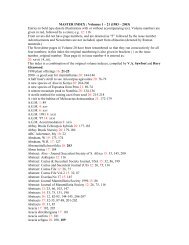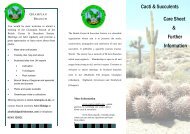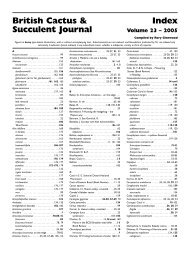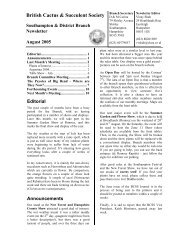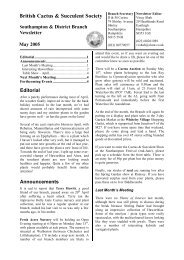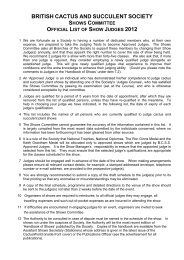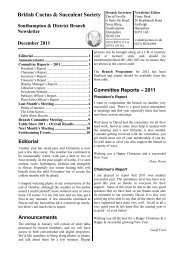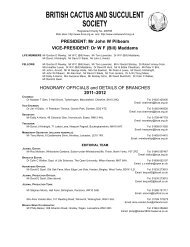Succulents - British Cactus & Succulent Society
Succulents - British Cactus & Succulent Society
Succulents - British Cactus & Succulent Society
Create successful ePaper yourself
Turn your PDF publications into a flip-book with our unique Google optimized e-Paper software.
leaf tips can be very sharp. Pieces of polystyrene or wine corksare useful for pushing on the end of the leaf to prevent damageif there are children or pets in the vicinity.Stem <strong><strong>Succulent</strong>s</strong>To make the most of any water around, a plant has to store asmuch as possible while reducing the natural loss through leaves.This is the strategy adopted by the stem succulents. Often youwill find their stems beautifully marked and examples of this arefound in the Euphorbiaceae (Euphorbia) (Fig. 11) and theAsclepiadaceae such as Stapelia and Huernia (Figs. 12 and 13).The production of a tuber or caudex above ground is a specialcase of stem succulence. These succulents are called caudiciforms.Some of these plants have the potential to grow intolarge shrubs and trees and most growers choose smaller orslow-growing species which are better suited to a windowsill orgreenhouse environment. They can be potted to display thecaudex above ground but care must be taken to ensure that thetuber does not get burnt on a hot day as this can damage theplant. Caudiciforms are not specific to one family and examplesare found in many different plant families. A popular, smallergrowing, caudiciform, which you will frequently find on theBCSS seed list is Dioscorea elephantipes (the elephants foot),(Fig. 14). This is a member of the Dioscoreaceae. Otherexamples of caudex growing plants suitable for the windowsillor greenhouse are species of Adenium and Pachypodium(Apocynaceae), Dorstenia (Moraceae), Fockea (Asclepiadaceae),Ipomoea (Convolvulaceae) and Pelargonium and Sarcocaulon(Fig. 15), (Geraniaceae).Photo: Alice Vanden BonPhoto: John PilbeamPhoto: Alice Vanden BonFig. 7 Crassula mesembrianthemopsisFig. 8 Echeveria runyoniiFig. 9 Dudleya pachyphytumPhoto: John PilbeamPhoto: Alice Vanden BonPhoto: Alice Vanden BonFig. 10 Agave titanotaFig. 11 Euphorbia obesaFig. 12 Stapelia giganteaPhoto: Alice Vanden BonPhoto: Tony MorrisPhoto: Bill WeightmanFig. 13 Huernia oculataFig. 14 Caudex of Dioscorea elephantipesFig. 15 Sarcocaulon herrei




